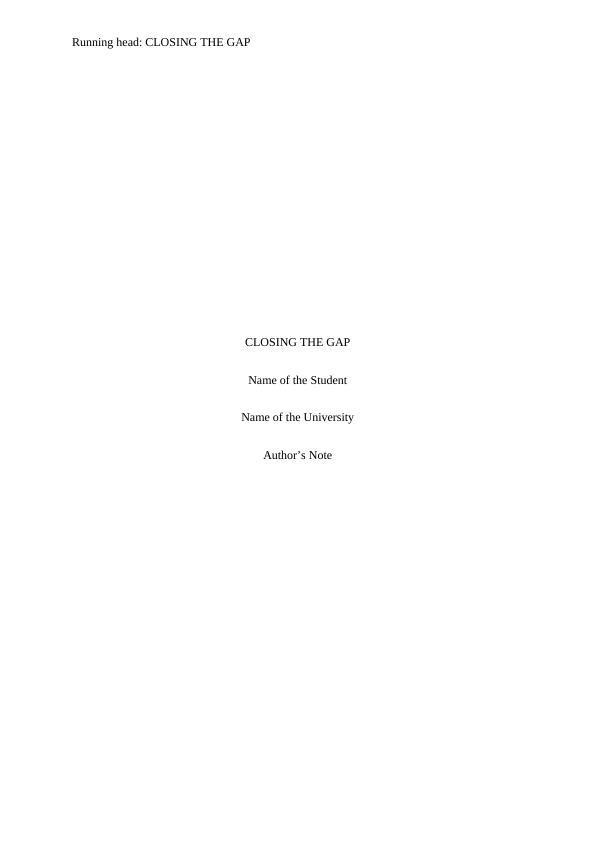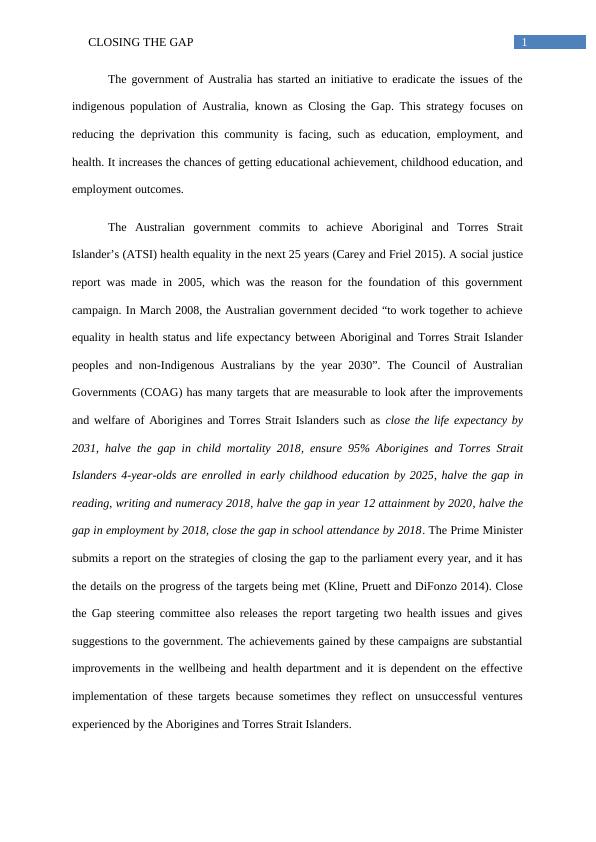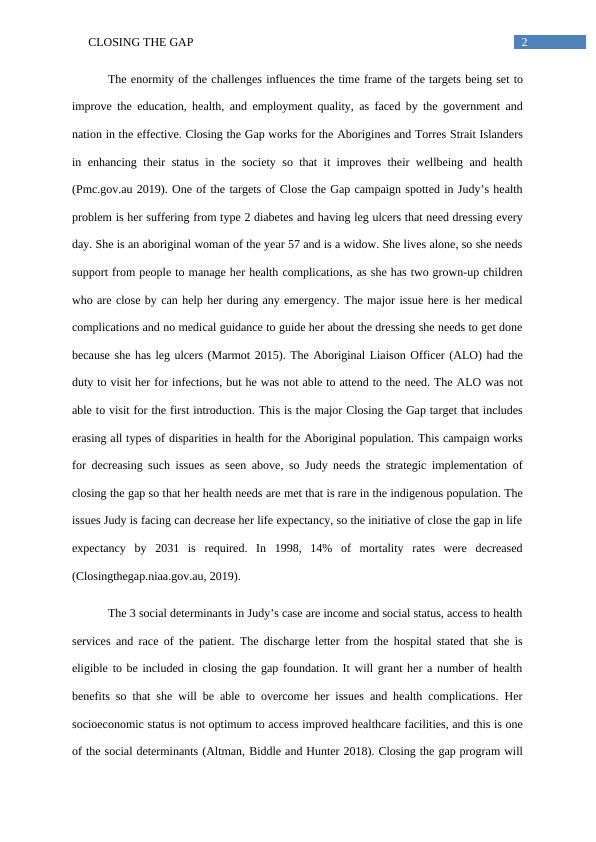Closing the Gap Strategy | Australia
Added on 2022-09-07
9 Pages2245 Words22 Views
Running head: CLOSING THE GAP
CLOSING THE GAP
Name of the Student
Name of the University
Author’s Note
CLOSING THE GAP
Name of the Student
Name of the University
Author’s Note

1CLOSING THE GAP
The government of Australia has started an initiative to eradicate the issues of the
indigenous population of Australia, known as Closing the Gap. This strategy focuses on
reducing the deprivation this community is facing, such as education, employment, and
health. It increases the chances of getting educational achievement, childhood education, and
employment outcomes.
The Australian government commits to achieve Aboriginal and Torres Strait
Islander’s (ATSI) health equality in the next 25 years (Carey and Friel 2015). A social justice
report was made in 2005, which was the reason for the foundation of this government
campaign. In March 2008, the Australian government decided “to work together to achieve
equality in health status and life expectancy between Aboriginal and Torres Strait Islander
peoples and non-Indigenous Australians by the year 2030”. The Council of Australian
Governments (COAG) has many targets that are measurable to look after the improvements
and welfare of Aborigines and Torres Strait Islanders such as close the life expectancy by
2031, halve the gap in child mortality 2018, ensure 95% Aborigines and Torres Strait
Islanders 4-year-olds are enrolled in early childhood education by 2025, halve the gap in
reading, writing and numeracy 2018, halve the gap in year 12 attainment by 2020, halve the
gap in employment by 2018, close the gap in school attendance by 2018. The Prime Minister
submits a report on the strategies of closing the gap to the parliament every year, and it has
the details on the progress of the targets being met (Kline, Pruett and DiFonzo 2014). Close
the Gap steering committee also releases the report targeting two health issues and gives
suggestions to the government. The achievements gained by these campaigns are substantial
improvements in the wellbeing and health department and it is dependent on the effective
implementation of these targets because sometimes they reflect on unsuccessful ventures
experienced by the Aborigines and Torres Strait Islanders.
The government of Australia has started an initiative to eradicate the issues of the
indigenous population of Australia, known as Closing the Gap. This strategy focuses on
reducing the deprivation this community is facing, such as education, employment, and
health. It increases the chances of getting educational achievement, childhood education, and
employment outcomes.
The Australian government commits to achieve Aboriginal and Torres Strait
Islander’s (ATSI) health equality in the next 25 years (Carey and Friel 2015). A social justice
report was made in 2005, which was the reason for the foundation of this government
campaign. In March 2008, the Australian government decided “to work together to achieve
equality in health status and life expectancy between Aboriginal and Torres Strait Islander
peoples and non-Indigenous Australians by the year 2030”. The Council of Australian
Governments (COAG) has many targets that are measurable to look after the improvements
and welfare of Aborigines and Torres Strait Islanders such as close the life expectancy by
2031, halve the gap in child mortality 2018, ensure 95% Aborigines and Torres Strait
Islanders 4-year-olds are enrolled in early childhood education by 2025, halve the gap in
reading, writing and numeracy 2018, halve the gap in year 12 attainment by 2020, halve the
gap in employment by 2018, close the gap in school attendance by 2018. The Prime Minister
submits a report on the strategies of closing the gap to the parliament every year, and it has
the details on the progress of the targets being met (Kline, Pruett and DiFonzo 2014). Close
the Gap steering committee also releases the report targeting two health issues and gives
suggestions to the government. The achievements gained by these campaigns are substantial
improvements in the wellbeing and health department and it is dependent on the effective
implementation of these targets because sometimes they reflect on unsuccessful ventures
experienced by the Aborigines and Torres Strait Islanders.

2CLOSING THE GAP
The enormity of the challenges influences the time frame of the targets being set to
improve the education, health, and employment quality, as faced by the government and
nation in the effective. Closing the Gap works for the Aborigines and Torres Strait Islanders
in enhancing their status in the society so that it improves their wellbeing and health
(Pmc.gov.au 2019). One of the targets of Close the Gap campaign spotted in Judy’s health
problem is her suffering from type 2 diabetes and having leg ulcers that need dressing every
day. She is an aboriginal woman of the year 57 and is a widow. She lives alone, so she needs
support from people to manage her health complications, as she has two grown-up children
who are close by can help her during any emergency. The major issue here is her medical
complications and no medical guidance to guide her about the dressing she needs to get done
because she has leg ulcers (Marmot 2015). The Aboriginal Liaison Officer (ALO) had the
duty to visit her for infections, but he was not able to attend to the need. The ALO was not
able to visit for the first introduction. This is the major Closing the Gap target that includes
erasing all types of disparities in health for the Aboriginal population. This campaign works
for decreasing such issues as seen above, so Judy needs the strategic implementation of
closing the gap so that her health needs are met that is rare in the indigenous population. The
issues Judy is facing can decrease her life expectancy, so the initiative of close the gap in life
expectancy by 2031 is required. In 1998, 14% of mortality rates were decreased
(Closingthegap.niaa.gov.au, 2019).
The 3 social determinants in Judy’s case are income and social status, access to health
services and race of the patient. The discharge letter from the hospital stated that she is
eligible to be included in closing the gap foundation. It will grant her a number of health
benefits so that she will be able to overcome her issues and health complications. Her
socioeconomic status is not optimum to access improved healthcare facilities, and this is one
of the social determinants (Altman, Biddle and Hunter 2018). Closing the gap program will
The enormity of the challenges influences the time frame of the targets being set to
improve the education, health, and employment quality, as faced by the government and
nation in the effective. Closing the Gap works for the Aborigines and Torres Strait Islanders
in enhancing their status in the society so that it improves their wellbeing and health
(Pmc.gov.au 2019). One of the targets of Close the Gap campaign spotted in Judy’s health
problem is her suffering from type 2 diabetes and having leg ulcers that need dressing every
day. She is an aboriginal woman of the year 57 and is a widow. She lives alone, so she needs
support from people to manage her health complications, as she has two grown-up children
who are close by can help her during any emergency. The major issue here is her medical
complications and no medical guidance to guide her about the dressing she needs to get done
because she has leg ulcers (Marmot 2015). The Aboriginal Liaison Officer (ALO) had the
duty to visit her for infections, but he was not able to attend to the need. The ALO was not
able to visit for the first introduction. This is the major Closing the Gap target that includes
erasing all types of disparities in health for the Aboriginal population. This campaign works
for decreasing such issues as seen above, so Judy needs the strategic implementation of
closing the gap so that her health needs are met that is rare in the indigenous population. The
issues Judy is facing can decrease her life expectancy, so the initiative of close the gap in life
expectancy by 2031 is required. In 1998, 14% of mortality rates were decreased
(Closingthegap.niaa.gov.au, 2019).
The 3 social determinants in Judy’s case are income and social status, access to health
services and race of the patient. The discharge letter from the hospital stated that she is
eligible to be included in closing the gap foundation. It will grant her a number of health
benefits so that she will be able to overcome her issues and health complications. Her
socioeconomic status is not optimum to access improved healthcare facilities, and this is one
of the social determinants (Altman, Biddle and Hunter 2018). Closing the gap program will

End of preview
Want to access all the pages? Upload your documents or become a member.
Related Documents
Closing the Gap Policy | Assignmentlg...
|8
|2134
|29
Contemporary Indigenous Health and Wellbeinglg...
|10
|2616
|445
Closing the Gap Strategy: A Governmental Approach to Achieve Health Equalitylg...
|17
|4482
|46
Aboriginal Health Gap Closinglg...
|9
|2583
|35
Contemporary Indigenous Health and Well Being | Reportlg...
|8
|2270
|25
Aboriginal and Torres Strait Islander Peoples Well-Being: Analysis of Healthcare Inequalities and Initiativeslg...
|10
|2500
|221
